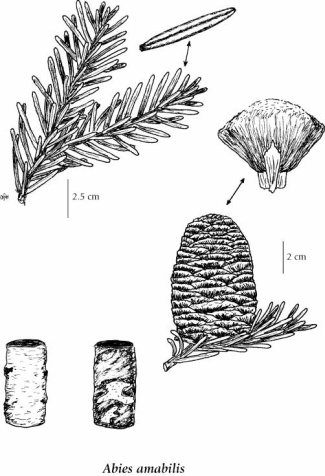amabilis fir (Pacific silver fir)
Pinaceae (Pine family)
Introduction to Vascular Plants
Introduction
This is a tall, evergreen, coniferous tree species found from Alaska south to northern California in forests with deep, well-drained soils.
|
Species Information
General:
Tall, straight tree, up to 55 m tall, with dense cylindric or conical crown; bark grey to nearly white, smooth but becoming scaly with age, with resin blisters; branches flattened and spray-like.
Leaves:
Needles flattened, blunt and mostly notched at the tip; shiny, dark green and grooved above, having two distinct silvery bands of stomata and ridged below; spreading to somewhat erect needles 1.5-3 cm long; strongly appressed needles on upper surface of twig 0.7-2 cm.
Cones:
Seed cones erect, deep purple, 8-10 (15) cm long, 3.5-4 (5) cm thick, the bracts deciduous; pollen cones reddish.
Illustration

If more than one illustration is available for a species (e.g., separate illustrations were provided for two subspecies) then links to the separate images will be provided below. Note that individual subspecies or varietal illustrations are not always available.
Illustration Source: The Illustrated Flora of British Columbia
USDA Species Characteristics
Flower Colour:
Yellow
Blooming Period:
Late Spring
Fruit/Seed characteristics:
Colour: Brown
Present from Summer to Fall
Source: The USDA
Ecology
The table below shows the species-specific information calculated from
original data (BEC database) provided by the BC Ministry of Forests and Range.
(Updated August, 2013)
| Site Information |
Value / Class |
||
|
Avg |
Min |
Max |
|
| Elevation
(metres) |
588 | 0 | 2400 |
| Slope
Gradient (%) |
27 | 0 | 410 |
|
Aspect (degrees) |
259 | 0 | 360 |
| Soil
Moisture Regime (SMR) [0 - very xeric; 4 - mesic; 8 - hydric] |
4 | 0 | 8 |
| Modal
Nutrient Regime
Class |
C | ||
| #
of field plots species was recorded in: |
3132 | ||
| Modal
BEC Zone Class |
CWH | ||
|
All BEC Zones (# of stations/zone) species was recorded in |
AT(2), CMA(2), CWH(2223), ESSF(178), ICH(105), IDF(16), MH(522), MS(60), SBPS(1), SBS(5) | ||
|
Source:
Klinkenberg 2013
|
|||
Habitat and Range
Moist to mesic forests with deep, well-drained soils in the lowland to subalpine zones; common in and W of Coast-Cascade Mountains, except Queen Charlotte Islands; N to SE AK and S to N CA.Status Information
Taxonomic Keys
1. Needles with stomata on both surfaces, blue-green and glaucous; branches not spray-like, leaves tending to curve upwards; trees with narrow crowns................Abies lasiocarpa
1. Needles with lines of white stomata on lower surface only, the upper surface green; branches mostly appearing spray-like, the leaves either all horizontally spreading or some spreading and the others depressed and pointing forward; trees with wide crowns. 2. Needles (2) 3-4 (5) cm long, nearly all horizontally spreading, the upper side of the twigs bare except for the twisted leaf bases; seed cones light green.........................Abies grandis 2. Needles mostly less than 2.5 cm long, the longer ones spreading horizontally, but others (usually shorter) strongly appressed and pointing forward on upper side of twig and more or less completely hiding the twigs; seed cones deep purple....................Abies amabilis Source: The Illustrated Flora of British Columbia |